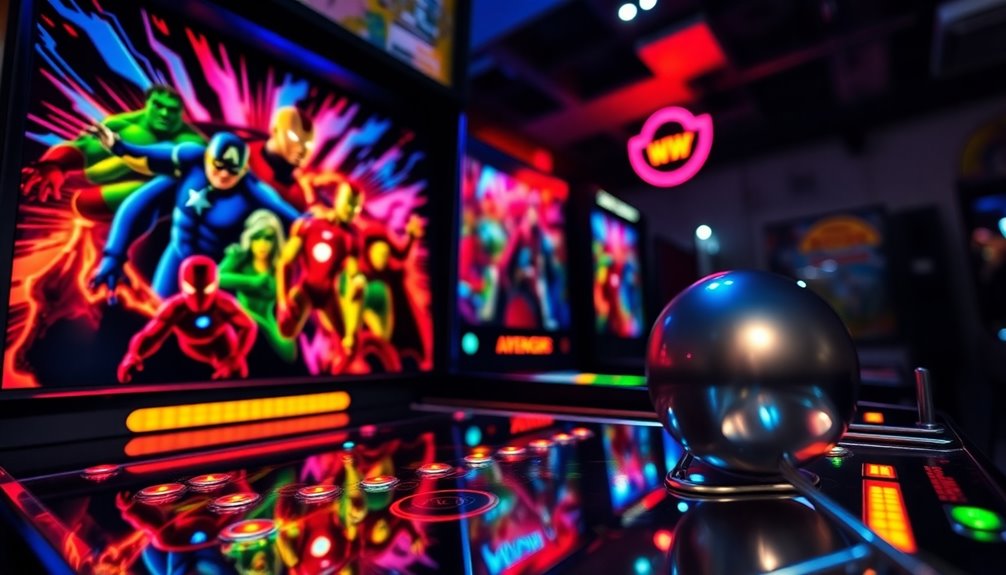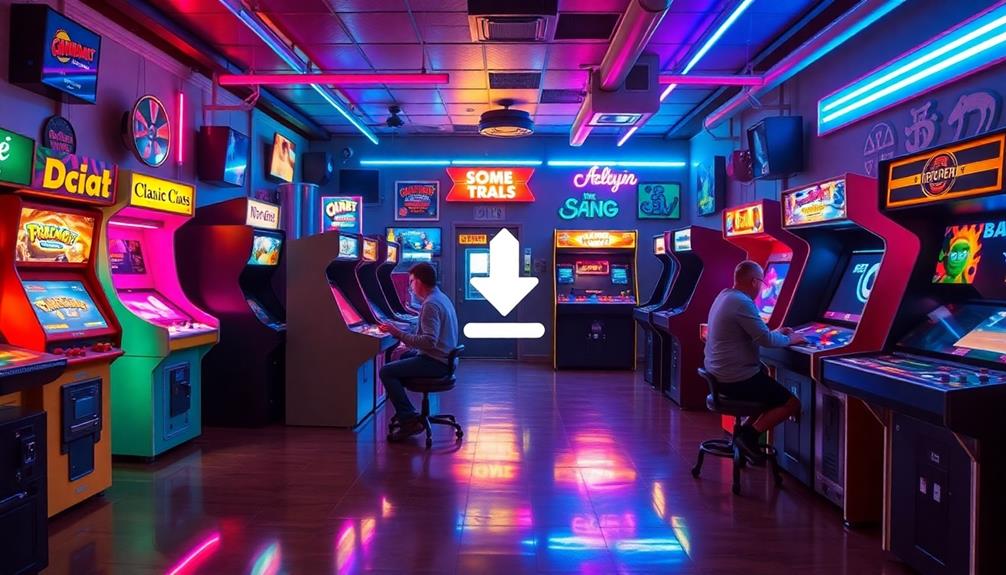Ms. Pac-Man burst onto the scene in 1981, becoming a revolutionary female icon in gaming. As a sequel to Pac-Man, she introduced unique maze designs and improved gameplay mechanics, captivating players worldwide. Not only did she challenge gender stereotypes, but she also highlighted the growing presence of female gamers. With her success, Ms. Pac-Man grossed over $1.2 billion, surpassing many competitors and earning her spot in the World Video Game Hall of Fame. Her lasting legacy continues to inspire discussions about representation and diversity in gaming. There's so much more to explore about her impact on the gaming industry.
Key Takeaways
- Ms. Pac-Man features a female protagonist, breaking traditional gender roles and appealing to a broader gaming audience.
- The game introduced significant gameplay innovations, enhancing complexity and replayability, which contributed to its popularity.
- By grossing $1.2 billion and surpassing Pac-Man's sales, Ms. Pac-Man became a cultural phenomenon and an industry landmark.
- Its success sparked discussions about gender representation in gaming, influencing character design and promoting diversity in the industry.
- Ms. Pac-Man remains relevant today, inspiring community events, modern adaptations, and ongoing academic discussions around gender and gaming.
Origins of Ms. Pac-Man
Have you ever wondered how Ms. Pac-Man came to be? Released in 1981, this game emerged as an unauthorized sequel to the original Pac-Man, created by the General Computer Corporation. It didn't take long for Ms. Pac-Man to capture the hearts of players, becoming an instant hit in arcade games. The game introduced a female protagonist, complete with a bow and lipstick, which marked a significant milestone for representation in gaming.
Designer Toru Iwatani, who created the original Pac-Man, didn't directly design Ms. Pac-Man. However, the game's success reflected the growing interest in diverse characters and narratives. Midway Manufacturing recognized its potential and filed copyrights in January 1982, anticipating it could match or surpass the original's popularity. By 1988, Ms. Pac-Man had sold 116,000 arcade cabinets, outpacing Pac-Man's 96,000 units.
This achievement not only solidified Ms. Pac-Man's status in the gaming world but also contributed to a cultural shift, highlighting the potential of female gamers and challenging industry stereotypes. Its universal appeal continues to resonate with players, making it a beloved classic in gaming history.
Development and Legal Challenges
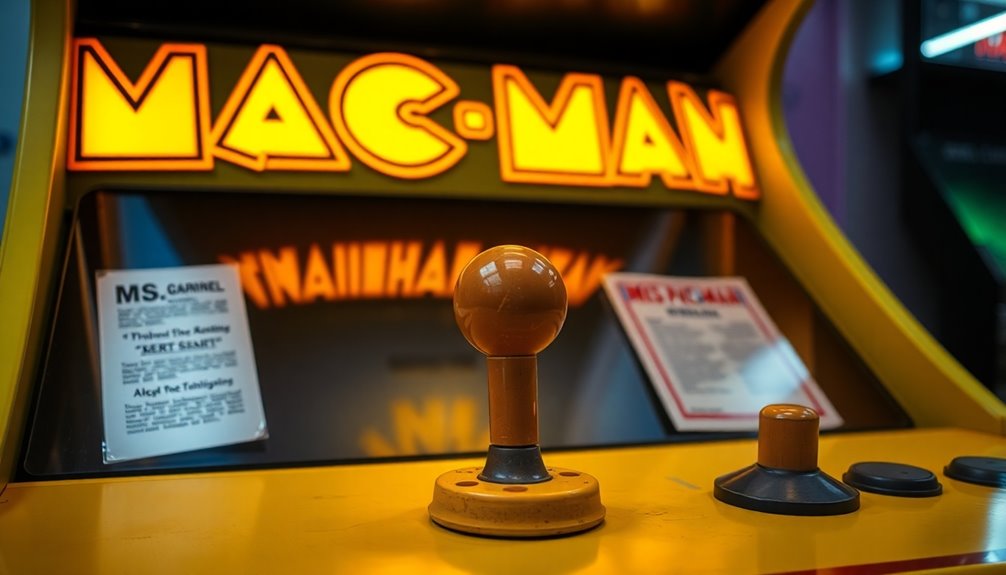
The journey of Ms. Pac-Man began as an unauthorized enhancement kit called Crazy Otto, created by the General Computer Corporation (GCC). This initial concept sparked legal battles over intellectual property rights with Namco, which owned the original Pac-Man. Recognizing the potential, Midway Manufacturing acquired the rights from GCC, allowing the game to be developed and released as a standalone title in 1981.
During the development process, the team made various changes to the name and character design before settling on the iconic Ms. Pac-Man. They infused her with feminine traits, aiming to attract a broader audience and enhance the game's appeal. Despite its success, legal disputes lingered, culminating in a settlement in 1983 over merchandise royalties between Midway and GCC. Even in 2008, Bandai Namco negotiated agreements with GCC stakeholders to address ongoing issues.
The game's remarkable success, with over 125,000 arcade units sold by 1988, can also be attributed to effective marketing strategies. These strategies emphasized the innovative gameplay and relatability of Ms. Pac-Man, solidifying her status as a beloved figure in gaming history.
Gameplay Innovations
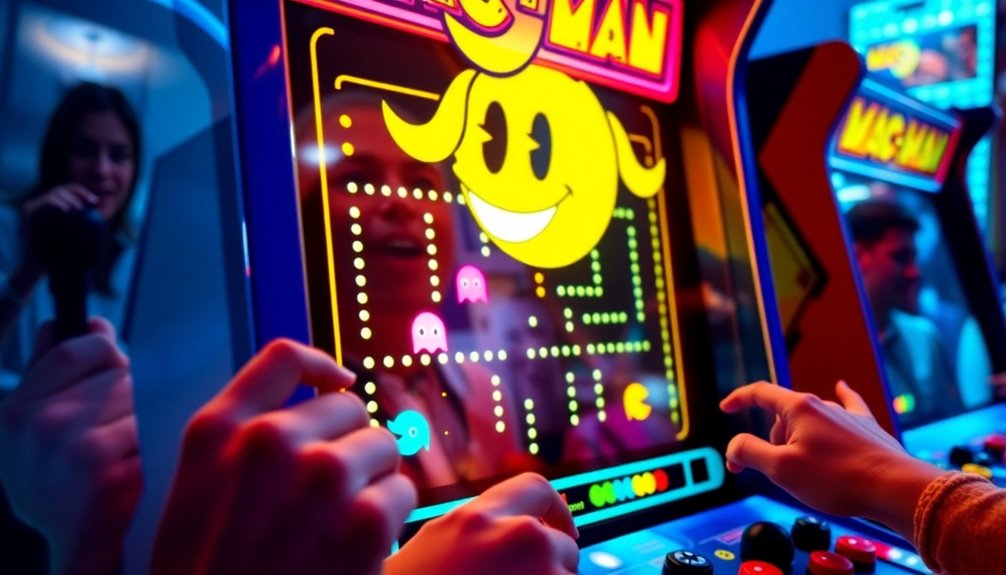
While many arcade games of the early '80s followed predictable patterns, Ms. Pac-Man broke the mold with its impressive gameplay innovations. One of the standout features is the improved ghost AI, which gives the ghosts non-deterministic behavior. This makes their movements less predictable, creating a thrilling challenge as you navigate the mazes.
The game introduces four unique mazes, each offering different layouts that significantly enhance the complexity and replayability. You'll find yourself strategizing differently with each new maze, keeping the gameplay fresh and engaging.
In addition to this, Ms. Pac-Man includes moving bonus fruits that provide additional scoring opportunities, adding an exciting layer of challenge. The classic pellet-eating mechanics remain, but the game introduces power pellets that allow you to eat ghosts for bonus points, increasing the strategic depth.
As you advance through the rounds, you'll notice the gameplay speed increases, further adjusting the difficulty and keeping you on your toes. These innovations not only elevate the gameplay experience but also ensure Ms. Pac-Man stands out as a beloved classic in the arcade gaming landscape.
Cultural Impact and Significance

Ms. Pac-Man isn't just a game; she's a cultural icon that transformed the gaming industry. Released in 1981, Ms. Pac-Man introduced a female protagonist at a time when most games featured male characters. This bold move significantly challenged gender stereotypes and marked a shift towards better female representation in gaming. By 1987, the game had grossed an impressive $1.2 billion and sold 125,000 arcade units, outpacing her predecessor, Pac-Man.
Her design, complete with a bow and lipstick, added a relatable touch that appealed to a diverse audience, including female gamers. This broadened the gaming demographic and encouraged game developers to consider female perspectives in their designs. Ms. Pac-Man topped numerous charts, including the RePlay upright cabinet charts for much of 1982, and was recognized as the highest-grossing arcade game that year.
In 2022, her legacy was cemented with an induction into the World Video Game Hall of Fame, showing that her influence continues to inspire discussions about female representation in gaming culture. Ms. Pac-Man's impact is undeniable, proving that female protagonists can resonate deeply and redefine an industry.
Representation of Female Gamers
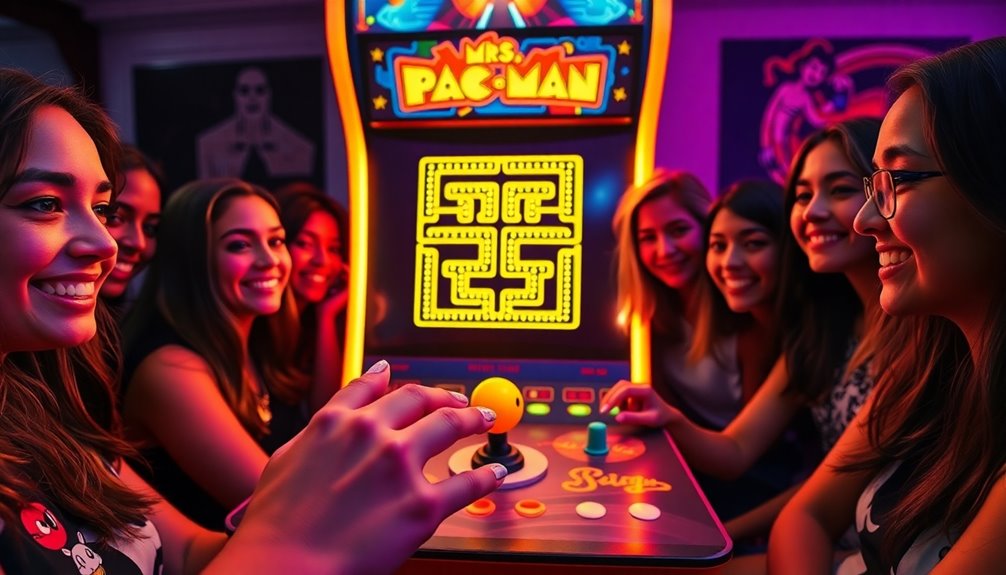
Representation of female gamers gained significant momentum with the introduction of Ms. Pac-Man in 1981. This game not only featured a female protagonist but also challenged traditional gender roles in gaming. By incorporating feminine traits like a bow and lipstick, Ms. Pac-Man appealed to both male and female players, fostering a more inclusive gaming environment.
The game's success highlighted a substantial female gaming audience, prompting industry leaders to reassess their approach to representation in games. As more women engaged with gaming, advertising campaigns began showcasing women as active players, reflecting their growing presence in arcade culture. Ms. Pac-Man served as a catalyst for this shift, sparking discussions about gender roles and the importance of diversity within the gaming community.
This increased visibility of female gamers paved the way for more games featuring strong female protagonists, encouraging both developers and players to embrace a broader spectrum of characters. Ultimately, Ms. Pac-Man's impact on representation laid the groundwork for future advancements in inclusive gaming, inviting a wider audience to explore the world of video games.
Marketing Strategies and Target Audience
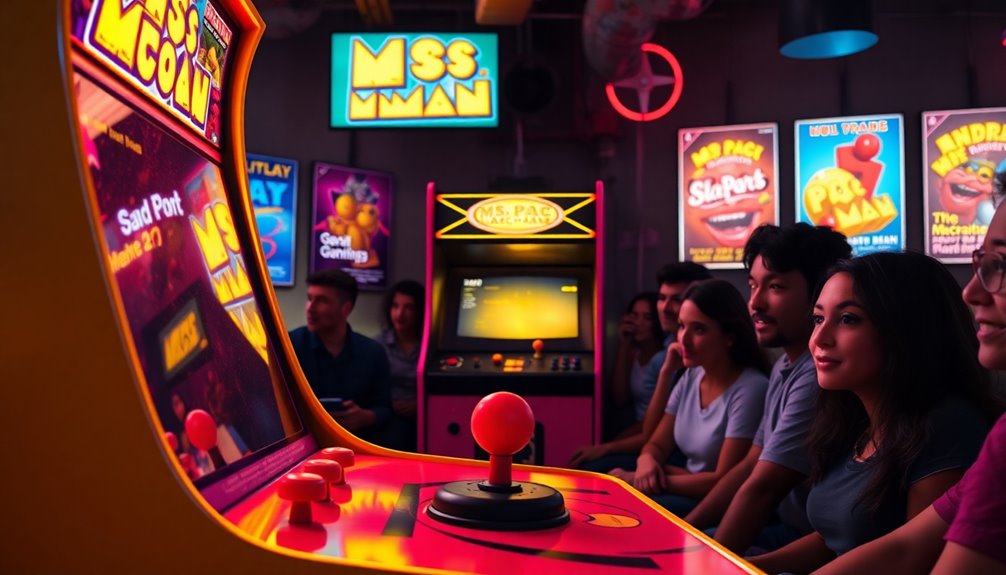
The impact of Ms. Pac-Man on the gaming industry was profound, as it prompted a reevaluation of marketing strategies that aimed to include female customers actively. The game's undeniable appeal showcased a growing presence of female players in arcades, leading to tailored advertising campaigns that targeted women. By featuring a relatable character, Ms. Pac-Man effectively engaged both male and female audiences, which significantly broadened its market reach.
This shift towards female-focused marketing highlighted the viability of catering to women in gaming, allowing industry leaders to acknowledge their contributions to gaming culture. As a result, the gaming industry began to embrace a more diverse audience, leading to a transformation in how games were advertised and developed.
The success of Ms. Pac-Man paved the way for future games to target wider demographics, ensuring that the gaming landscape became increasingly inclusive. By recognizing and responding to the desires of female gamers, the industry not only enhanced its market potential but also fostered a more welcoming environment for all players. Ultimately, Ms. Pac-Man's influence reshaped the gaming world, embracing diversity and transforming marketing strategies for years to come.
In addition, the game's success demonstrates the importance of maintaining positive energy to influence opportunities within the gaming market.
Legacy and Reception
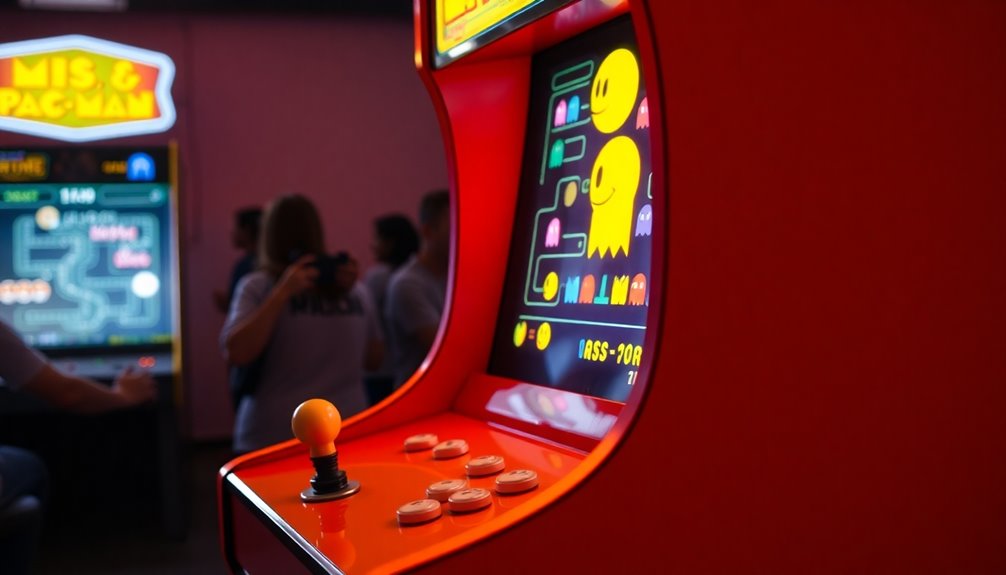
With its enduring charm and innovative gameplay, Ms. Pac-Man carved out a significant place in gaming history. Recognized for its impact, the game was inducted into the World Video Game Hall of Fame in 2022. You can see its legacy reflected in the impressive sales figures—by 1988, it sold 125,000 arcade units, far surpassing its predecessor, Pac-Man. In 1982, it even topped the RePlay upright cabinet charts, grossing a staggering $1.2 billion by 1987.
Critics and players alike frequently rank Ms. Pac-Man among the greatest video games of all time. Publications like Electronic Gaming Monthly and Next Generation have celebrated its achievements, underscoring its role in shaping gaming culture. This female icon not only changed the landscape of arcade games but also influenced character design and inclusivity in the industry.
Even in modern gaming culture, Ms. Pac-Man continues to resonate, appearing in various compilations and crossover titles, such as Super Smash Bros. Ultimate in 2018. Its legacy lives on, inspiring new generations and proving that a female character can lead in a male-dominated space.
Adaptations and Merchandise
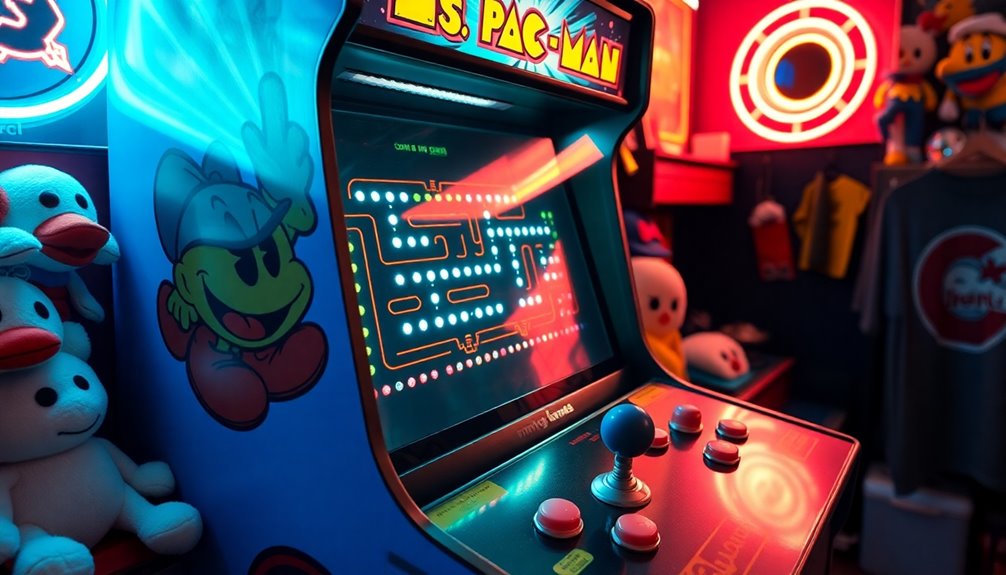
Numerous adaptations of Ms. Pac-Man have emerged over the years, ensuring the game's continued relevance in gaming culture. You've likely encountered home versions on platforms like Atari, NES, PlayStation, and Xbox, allowing you to enjoy the classic gameplay experience from the comfort of your living room. The game's influence doesn't stop there; it has also appeared in modern compilations and crossovers, such as Sonic Dash and Super Smash Bros. Ultimate, connecting it to a new generation of gamers.
When it comes to merchandise, Ms. Pac-Man has made a significant impact. You can find a variety of collectible figurines, apparel, and even new arcade cabinets that pay homage to the iconic game. These items reflect its cultural significance and keep the nostalgia alive.
Moreover, the game has seen re-releases in arcade cabinets, appealing to both retro enthusiasts and newcomers alike. For a more portable option, Jakks Pacific has created a standalone battery-powered version that connects to TVs, illustrating Ms. Pac-Man's adaptability in today's gaming market. This blend of adaptations and merchandise solidifies her status as a timeless gaming icon.
Modern Relevance and Community
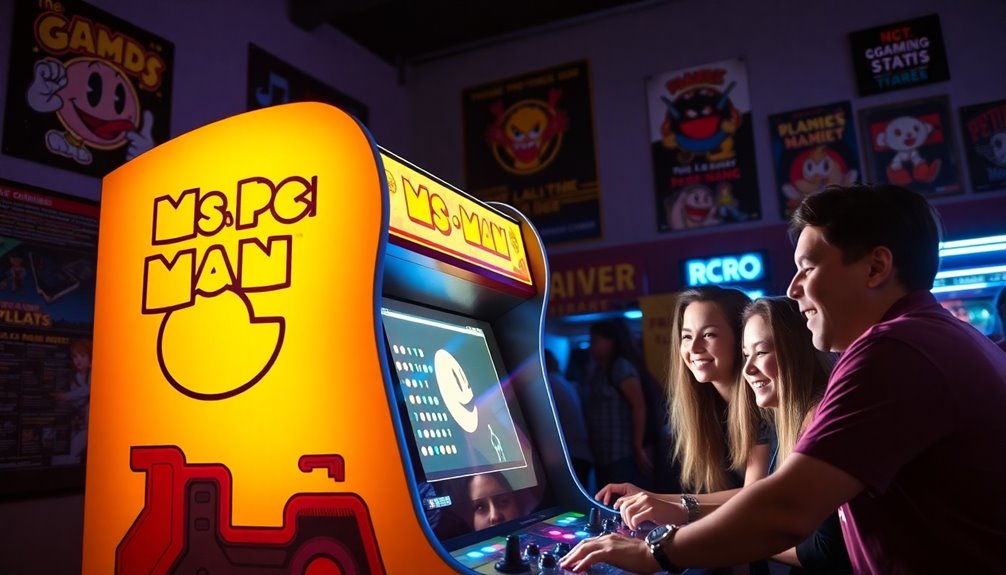
Ms. Pac-Man isn't just a nostalgic title; she remains a vibrant part of modern gaming culture. As a gaming icon, she's inspired a passionate community that celebrates her legacy through online forums and social media. You'll find dedicated fans discussing gameplay, strategies, and the character's significance in today's gaming landscape. Community events, like retro gaming tournaments and themed gatherings, keep her spirit alive, drawing in both nostalgic players and newcomers eager to experience her charm.
Moreover, Ms. Pac-Man's influence is evident in modern adaptations and remakes that introduce her to new audiences while retaining her classic appeal. These adaptations ensure her presence in contemporary gaming, making her relevant for generations to come.
Academic discussions around gender representation often reference Ms. Pac-Man, highlighting her role as a pioneering female character in a male-dominated industry. This ongoing dialogue reinforces her importance and relevance within the gaming community, ensuring that she remains a symbol of diversity and empowerment. By engaging in community events and exploring her modern adaptations, you can truly appreciate why Ms. Pac-Man continues to be an enduring icon in gaming.
Influence on Game Design
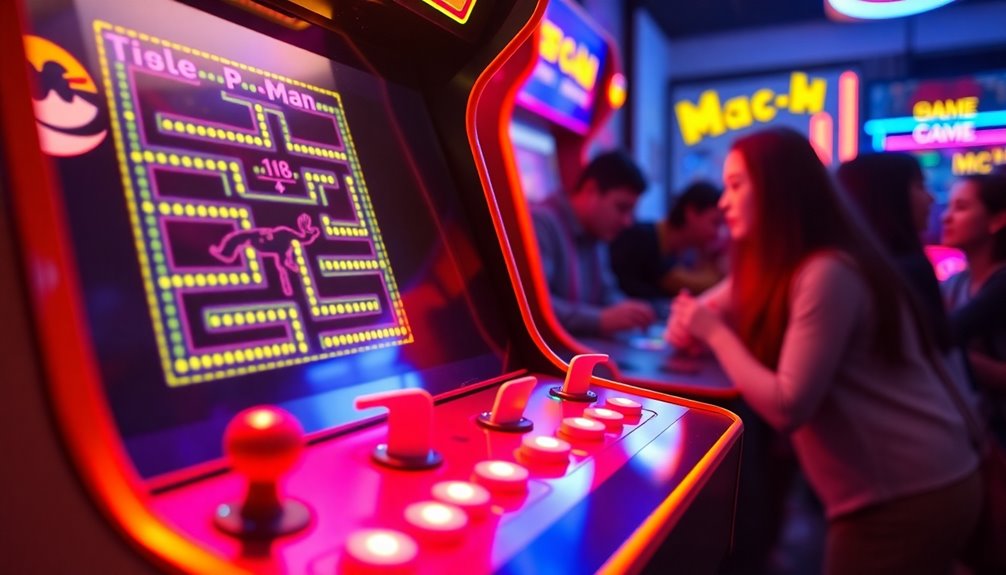
The groundbreaking design elements in Ms. Pac-Man significantly influenced game design, particularly in the arcade industry. By introducing non-deterministic AI for ghost behavior, it enhanced gameplay unpredictability, making each session a fresh challenge. You'll notice that the game features four distinct maze designs, which contribute to the increased complexity and player engagement. This variety encourages you to develop different navigation strategies each time you play.
Moreover, the addition of moving bonus fruits that appear randomly adds an element of surprise and strategy, requiring you to adapt your tactics on-the-fly. But it's not just the mechanics that set Ms. Pac-Man apart; her character design—including a bow and feminine traits—set a precedent for more relatable and diverse female characters in future video games.
The game's success also prompted the arcade industry to recognize and target a broader demographic, leading to the development of games designed with female players in mind. Ultimately, Ms. Pac-Man reshaped expectations for character representation and gameplay dynamics, paving the way for a richer, more inclusive gaming experience.
Frequently Asked Questions
What Is the Name of the Female Pac-Man?
The female character in the iconic game is called Ms. Pac-Man. She's designed with distinct feminine traits and quickly became a beloved figure, offering a fresh twist on the classic Pac-Man gameplay you know.
Why Is She Called Ms. Pac-Man?
She's called Ms. Pac-Man to signify her as a female counterpart to Pac-Man. The title reflects a nod to women's independence and empowerment during the early 1980s, celebrating female representation in gaming.
What Is the Difference Between Mrs Pac-Man and Pac-Man?
The main differences between Mrs. Pac-Man and Pac-Man include updated maze designs, faster gameplay, improved ghost AI, and moving bonus fruits. You'll also notice Mrs. Pac-Man's distinct character design with feminine elements like a bow and lipstick.
How Many Levels Are in Mrs. Pac-Man?
There're a total of 256 levels in Ms. Pac-Man. You'll navigate through various maze designs, facing increasing challenges, with the gameplay cycling through four distinct layouts before hitting the infamous kill screen at level 256.
Conclusion
In conclusion, Ms. Pac-Man isn't just a classic arcade game; she's a symbol of female empowerment in gaming. Her innovative gameplay and cultural significance paved the way for future female characters and gamers alike. As you revisit this iconic title, remember its lasting impact on both the industry and representation. Ms. Pac-Man continues to inspire new generations, proving that her legacy lives on in the hearts of players and developers everywhere.
